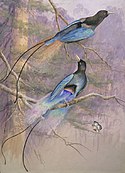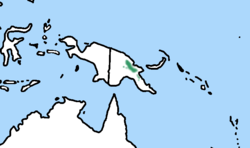Foreign birds for cage and aviary (1910) (14568883900)
Identifier: foreignbirdsforc02butl (find matches)
Title: Foreign birds for cage and aviary
Year: 1910 (1910s)
Authors: Butler, Arthur Gardiner, 1844-1925
Subjects: Cage birds
Publisher: London, "The Feathered world"
Contributing Library: American Museum of Natural History Library
Digitizing Sponsor: Biodiversity Heritage Library
View Book Page: Book Viewer
About This Book: Catalog Entry
View All Images: All Images From Book
Click here to view book online to see this illustration in context in a browseable online version of this book.
Text Appearing Before Image:
fact in no way disturbed my faith, because frommy boyhood I had been taught that the quarrels oflovers are the beginning of love. When in Jidy, 1904, the supposed hen began to assumemale plumage and became so spiteful that I had toremove the undoubted cock, I concluded, as a matterof course, that disease of the ovary was affecting herplumage (see my short paper in the Annals andMagazine of Natural History, Seventh Series, Vol.XVI., pp. 350-351). Later the perfect male plumage wasacquired and retained permanently, and e.xactl,y threeyears later the bird died and proved to be a cock. Why some cock birds should assume male plumage atthe end of the second year, and others should disportthemselves in female attire for six years or longer, is aproblem which requires a good deal of explanation,ily birds were only two out of half a dozen or more,ail palpably young birds, imported in one batch. In 1902 (the Avicultunil Magazine, Second Series,Vol. I., pp. 63-58) Mrs. Johnstone published an in-
Text Appearing After Image:
The Blue (Prince Rudolphs) Hird of Paradise. FOREIGN BIRDS FOR CAGE AND AVIARY. tercEting account of the nesting of this species in heraviaries. Unhappily no young were reared to perfec-tion. As regards feeding, I found that Goulds idea thatthis species is very slightly, if at all, insectivorous wasquite erroneous. It wijl swallow cotkroaches one afterth; other with the greatest avidity, as well as any otherinsects or smooth larva? which one may supply, and,of course, spiders. Grapes are much relished, butbanana, ripe pear, apple or orange are also eaten freely.Insectivorous food is taken in moderation, but theyolk of egg is always first selected and the remainderof the food only taken when the birds are hungry.Australian C.at-Bird (.Elurcediis viridis). Above bright grass-green; a whitish patch on sideof lower neck; median and greater wing-coverts andsecondaries with yellowish-white tips; primariesslightly bluish on outer webs; inner webs of all theflights grey-brownish; tail feather
Note About Images
Relevante Bilder
Relevante Artikel
BlauparadiesvogelDer Blauparadiesvogel ist ein Vogelart der Gattung der Eigentlichen Paradiesvögel (Paradisaea) aus der Familie der Paradiesvögel (Paradisaeidae), die ausschließlich in einem kleinen Gebiet in Papua-Neuguineas vorkommt, wo sie nur Höhenlagen besiedeln. Obwohl das Verbreitungsgebiet klein ist, werden zwei Unterarten unterschieden. Die adulten Männchen, die leuchtend blaue Flügel und seidenartig verlängerte Flankenfedern haben, gelten als einer der schönsten Arten innerhalb der Familie der Paradiesvögel. .. weiterlesen





